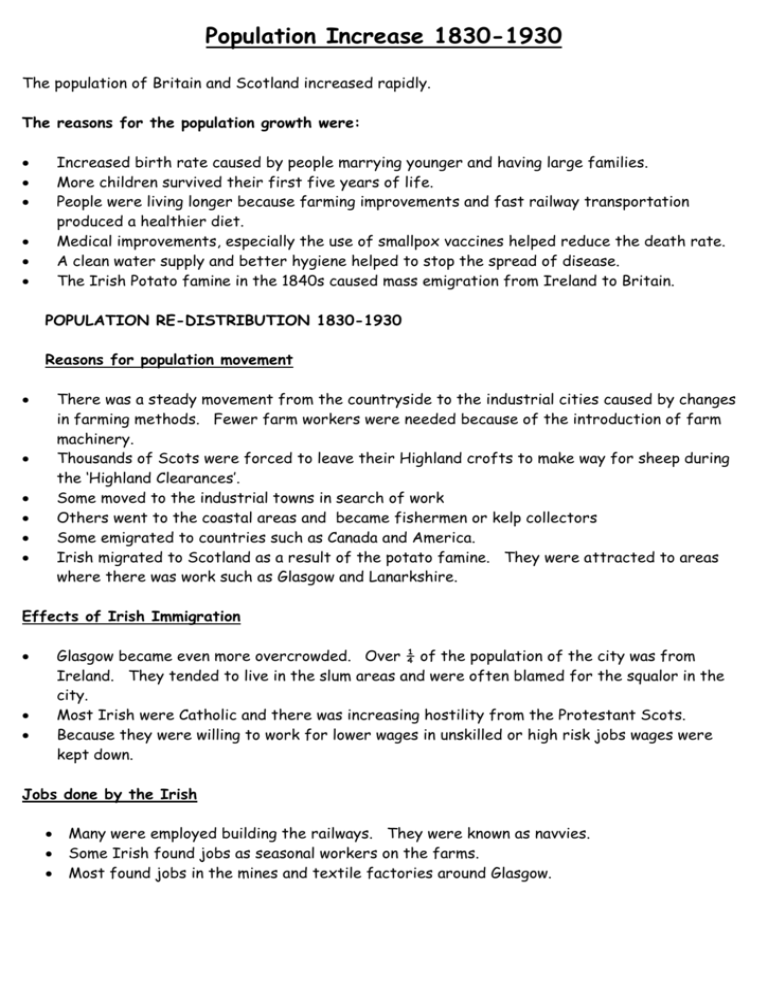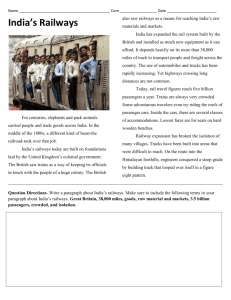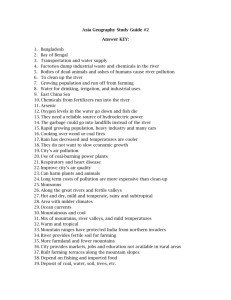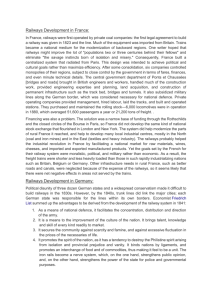Changes in Agriculture 1830-1930
advertisement

Population Increase 1830-1930 The population of Britain and Scotland increased rapidly. The reasons for the population growth were: Increased birth rate caused by people marrying younger and having large families. More children survived their first five years of life. People were living longer because farming improvements and fast railway transportation produced a healthier diet. Medical improvements, especially the use of smallpox vaccines helped reduce the death rate. A clean water supply and better hygiene helped to stop the spread of disease. The Irish Potato famine in the 1840s caused mass emigration from Ireland to Britain. POPULATION RE-DISTRIBUTION 1830-1930 Reasons for population movement There was a steady movement from the countryside to the industrial cities caused by changes in farming methods. Fewer farm workers were needed because of the introduction of farm machinery. Thousands of Scots were forced to leave their Highland crofts to make way for sheep during the ‘Highland Clearances’. Some moved to the industrial towns in search of work Others went to the coastal areas and became fishermen or kelp collectors Some emigrated to countries such as Canada and America. Irish migrated to Scotland as a result of the potato famine. They were attracted to areas where there was work such as Glasgow and Lanarkshire. Effects of Irish Immigration Glasgow became even more overcrowded. Over ¼ of the population of the city was from Ireland. They tended to live in the slum areas and were often blamed for the squalor in the city. Most Irish were Catholic and there was increasing hostility from the Protestant Scots. Because they were willing to work for lower wages in unskilled or high risk jobs wages were kept down. Jobs done by the Irish Many were employed building the railways. They were known as navvies. Some Irish found jobs as seasonal workers on the farms. Most found jobs in the mines and textile factories around Glasgow. Changes in Agriculture 1830-1930 Farming methods changed greatly between 1830-1930. The following was introduced which made farming more efficient and increased the yield. Fertilisers (Guano, Superphosphates) Drainage Crop Rotation Enclosures When Railways were introduced after the 1830s farm produce could be transported faster to towns and cities. Machinery Hand tools such as the sickle, scythe and flail were replaced by machinery. Ploughing became more efficient with the introduction of the lighter steel plough pulled by Clydesdale horses. The new machines were: Bells Reaper - used for harvesting Steam threshing machines - separating grain from stalk Seed drill - used to sow the seeds After World War 1 tractors began to be used on farms. Working Conditions Worked long hours – Dawn to Dusk Low wages Hired at feeing market for 6 months at a time 1 day off per year (New Year’s day) Many people lost their jobs after the introduction of new machinery. Living Conditions The farmers provided accommodation like: Chaumers - for single men, close to the farm house Bothies - for groups of single men where they would sleep and eat Tied cottages - for families Lofts or attics - for single women Prosperity in Farming 1830-1870 After 1870 1914-18 - was known as the Golden Age of farming - farming was hit by foreign competition (Refrigerated cargo ships) - farmers prospered due to the U-boat campaign. This meant that Britain had to produce her own food. The women’s Land Army helped to do this. After 1918 - farming went into decline Coal Mining 1830 — 1930 Summary Sheet Working conditions in 1830 Whole families would work in the coal mines. Fathers as Hewers (cutting coal), mothers and older daughters as Bearers (lift coal up ladders to top of mine), sons and younger daugheters as Pushers/Putters (moving carts of caol) and young children as Trappers (open and shut ventilation doors). The work was extremely dangerous — accidents were common. As mines became deeper and deeper further dangers arose: Cave—ins Poisonous gas Flooding Explosions Coal dust leading to lung cancer Injuries to women and children carrying the coal to the surface Improved technology Humphrey Davy invented the safety lamp which helped prevent explosions in mines. 1860’s Steam power used in mines . Pumps drained water from the mines and ventilation pumps got rid of dangerous gasses. Steam driven winches were used to haul coal to the surface. Wire rope was used. Wooden and Iron pit props were used to support the roof and prevent cave —ins. 1890’s Electricity used in some mines 1920’s Mechanical cutting machines were introduced in some pits The Mines Act 1842 Following a Royal Commission Report which highlighted the dangerous working conditions , women and girls were forbidden from working underground. In addition no boy under 10 years old was permitted to work in a mine. Inspectors were appointed to enforce these rules. Government Reforms 1862 — Single mine shafts were declared illegal 1860 — boys were not allowed underground until the age of 12 1872 - Mine managers had to have a certificate to prove they could do the job. 1908 - Miners restricted to working an 8 hour shift. 1917 — Government took control of the mines till the end of the war. Mining in the 1920’s The coal mining industry faced many problems; • Cheap foreign coal was being imported • Many mine owners could not afford to modernise their pits • Less coal was needed as many industries changed from steam to electric power • Cars and lorries were replacing steam railways meaning less coal was needed. General Strike 1926 : Miners went on strike for 7 months in 1926 after owners tried to reduce their wages and increase their hours in order to cut their costs. Other workers came out on strike in sympathy but the miners were still defeated. Railways 1830-1930 — Summary Sheet Technology Until the early 19th century the main ways of travelling were by road or canal. By 1830 a locomotive steam engine had been invented to travel on iron rails. Railways were extremely difficult to build. Cuttings and embankments were made a using a pick and shovel. Tunnels were constructed through mountains using gun powder — this was very dangerous. Bridges were built to solve the problems of crossing firths and rivers. Viaducts were built of brick. At first trains were very uncomfortable and travelled at a top speed of 29 mph. By 1900 they had become much faster. Roofs, windows, toilets, heating and buffet cars were introduced. The Navvies Most of Britain’s main railway lines were built by 1860. Railways were built by navvies who often came from Ireland or the Highlands of Scotland and their work was extremely dangerous and accidents were common. Navvies had a bad name for drinking and fighting and some were violent and rude — but without them the railways would not have been built. Their work was done using hand tools: shovel, pick and wheelbarrow. Also navvies built bridges, viaducts and embankments. Economic effects of the railways • • • • • Canals and coach companies declined. The coal and iron industry boomed as coal could be transported quickly and cheaply. Factories were built near railways for transporting finished goods. Ports and harbours grew as export increased. Employment was created — 100,000 people working on the railways —porters, drivers, ticket collectors, maintenance men. • Farmers could sell their produce anywhere in Britain. The social effects of the railways The whole of Britain went onto standard time. Fresh food could be taken anywhere in Britain and people’s diets improved. Middle class could live in suburbs and travel to work by train._ Working class began to take holidays by the sea. Growth in holiday towns New or older towns grew if they were near a railway line. Others, which were not, declined. Newspapers and letters delivered by train so news travelled faster. People could visit friends and relatives who lived further away. The Suffragettes - The Women’s Social and Political Union was set up by Emmeline Pankhurst in 1903. At first they campaigned using peaceful methods (followed the Suffragists’ methods (set-up by Millicent Fawcett) - Wrote letters - Organised petitions - Published pamphlets - Attended political meetings - Organised rallies and processions Militant Tactics After 1906 the WSPU became militant. This was because they felt that their peaceful protests were being ignored. Some women did not agree with this and remained peaceful – they became known as the Suffragists. Militant tactics included - Acid on golf courses - Burning public buildings - Smashing windows - Telephone wires cut Emily Davidson threw herself in front of the king’s horse at the Derby in 1913. She died as a result of her fall. Some people claimed that the militant tactics brought lots of publicity to the suffragette cause. Others felt that it made women seem irresponsible and not worthy of the vote. Hunger Strikes Women sent to jail went on hunger strike and were force fed. This turned out to be dangerous and was gaining bad publicity for the Government. The Cat and Mouse Act allowed women who had been on hunger strike to be released from prison. When they recovered, they were re-arrested to complete their sentences. World War One The Suffragette Campaign stopped Large numbers of women were employed in essential war work e.g. working in munitions factories and in the Women’s Land Army Many politicians changed their opinion about giving women the vote 1918 women over the age of 30 got the vote 1928 all women over the age of 21 given the vote Parliamentary Reform 1867-1928 Before 1867 Only 7% of the adult population had the vote or franchise Voting was done in the open at the hustings – there was a lot of corruption and bribery Parliament was made up of landowners. They made laws to suit themselves. Constituencies varied greatly in size. 1867 Reform Act Increased the number of male voters by giving the franchise to householders in the towns. Now 16% of the adult population could vote. 1872 Secret Ballot Act Meant voting took place in secret, reducing corruption at elections. 1884 Reform Act This Act doubled the electorate which increased from 2.5 million to 5 million males. Many householders in the countryside got the vote. 1885 Redistribution of Seats Act Made constituencies more equal in terms of number of voters and created more constituencies in towns and cities. 1911 Parliament Act Took away some of the powers of the House of Lords Payment of M.P.s meant that more working-class men could afford to become MPs. 1918 Reform Act Gave all males over the age of 21 the vote Gave the vote to women over 30 Increased the % of people who could vote to 74% 1928 Reform Act Gave the vote to all women over the age of 21 LIVING CONDITIONS IN SCOTLAND AND BRITAIN 1830 TO 1930 Rural Housing in the 19th Century Wealthy landowners had large luxurious houses with lots of servants. Tenant farmers had stone farmhouses — better built and equipped in the richer parts of the country than in the Highlands and Islands. Poor farmers in the Highlands and Islands lived in black houses, sharing them with their animals, which could be a health hazard e.g. tuberculosis. Poor amenities e.g. earth floors, no proper chimney. Farm labourers lived in bothies — shared rooms, no privacy. Urban housing in the 19th century The better off people lived in pleasant, large houses on the edge of town, upwind of the smoke and smell. In Edinburgh many lived in large stone built New Town houses, where they had the whole house to themselves and their servants. Poorer people lived in poor quality housing which was overcrowded due to the influx of people from the countryside during the Industrial Revolution. Often these dwellings had been built quickly to accommodate the workers and often they were of poor quality. Edinburgh and Glasgow were very overcrowded — Old Town tenements or lands having many families in one room. They were dirty, damp and poorly ventilated with few windows, had no running water, bathrooms or toilets all causing disease. The streets were dirty and often contaminated with sewage as there was no proper system to take it away. In Edinburgh, rubbish was thrown out of tenement windows onto the streets. In London, the Thames was polluted with raw sewage. In many industrial towns houses were built over or near cess pits which contaminated the drinking water. Communal toilets were shared between many people and often overflowing with effluent. Nightmen had the horrible job of carting away the effluent __ often this wasn’t done well as no-one wanted the job. Disease These conditions were a breeding ground for many diseases and epidemics. Several deadly cholera epidemics spread throughout Britain after coming to these shores from Asia on board ships. Thousands of people died, rich and poor alike, as the disease spread through the drinking water. Other common diseases were typhoid, typhus, tuberculosis and many childhood diseases like diphtheria and hooping-cough which killed thousands of young children. Improvements Why? • • • • • • the terrible cholera epidemics hit rich and poor alike. The rich had more influence than the poor and pressured the authorities into making improvements in public health most (male) citizens got the vote after 1885 so had influence over the authorities to make changes studies by Booth, Rowntree and others revealed the true extent of poverty and ill health the Boer War showed up the poor health of many young men signing up as soldiers people like Edwin Chadwick, Beatrice Webb, David Lloyd-George all worked to do something about poverty and ill health technologies improved and were more affordable eg flushing toilets. What improvements? 1. Public Health Acts after 1848 introduced rules for local authorities to follow to make sure there were doctors, hospitals, health inspectors etc in each town. 2. Water supplies were cleaned up by citing reservoirs far out of towns in the hills. Sewage systems were built to take away the effluent. 3. Medical advances e.g. anaesthetics, antiseptics, clean hospitals, penicillin dramatically improved the chances of surviving childbirth and illness. 4. Housing was vastly improved slums were pulled down and replaced by council houses after World War 1, building regulations made for better quality homes, Conservative governments subsidised private builders to provide homes for the middle classes to own. How much improvement? Living conditions, housing and health improved dramatically by 1930 with much lower infant mortality and much longer life expectancy. Most of the killer epidemics had been conquered and houses were much better. But, many slums remained and were not fully cleared till the 1960s. HOUSING PROBLEMS IN TOWNS 1830 1842 Overcrowding Poorly built Too close together No running water: No drains/sewers Damp: Cold Dung heaps: Animals Edwin Chadwick’s Report to Parliament “The Sanitary Conditions of the Labouring Population” This report gave details of how unsanitary or overcrowded conditions suffered by working people led to spread of disease and death. It said there should be (i) Drains, sewers (ii) Rubbish should be removed from streets (iii) Purer water (iv) A medical officer of health for each district but nothing happened until 1848 when there was another outbreak of cholera. 1848 PUBLIC HEALTH ACT Towns given power to set up boards of health to see that new houses had drains and lavatories and were supplied with pure water. But not a lot happened. Why? (i) Cost money: who would pay (ii) Wanted to keep dung heaps (iii) Didn’t want interference 1872 – 75 PUBLIC HEALTH ACTS Local councils had to lay sewers, drains and pavements Street lighting Street cleansing had to be done Fire services Medical officers of health were appointed to deal with infections and to stop diseases spreading Sanitary inspectors were appointed – checked streets were kept clean Councils could provide water and lavatories where necessary But these improvements were difficult to carry out in the older parts of towns. 1872 ARTISAN’S DWELLING ACT Allowed councils the power to take over and demolish slums. But councils had to find the money for the improvements. So improvement was very slow. Still a huge need for new houses 1919 ADDISON’S ACT Lloyd George had promised soldiers returning from the trenches “Homes fit for heroes”. The government gave local councils money to build houses. Over 200,000 were built. But it was abandoned because the government stopped giving money. But still a huge need for large numbers of good quality housing at affordable rents. Several other acts were passed to try and solve the problem. 1930 GREENWOOD’S ACT Returned to giving councils money (grants) to clear slums and build new houses. But still a major problem Not enough well built houses at affordable rents existed. There had been large improvements from the 19th century but still too many people living in slums.






